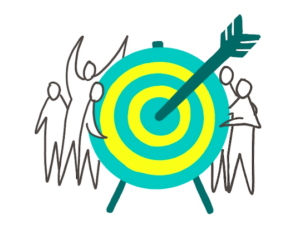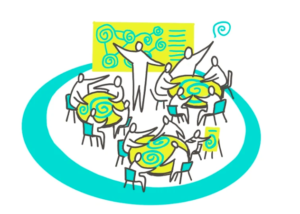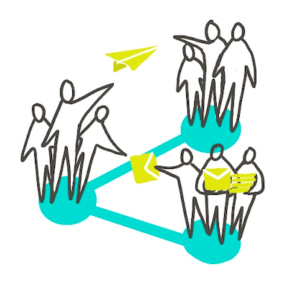Want to make your next event climate- and eco-friendly? Here are 6 things you have probably not considered yet!
Climate- and eco-friendly meetings & conferences are not just about minimizing energy use and having reusable cups. It is a start of course, but much more that can be done. Meetings and conferences require an incredible investment of resources, time and effort. This is not only an investment by organizers, but also by participants and ultimately also the ecosystem we are part of.
With that in mind, we are often surprised how ineffective events are: Isn’t any ecological impact produced at an event that is ineffective a waste of resources? From our experience with event design, it seems safe to assume that most events only create about 10% of the potential added value they could.
Take a short test to find out how climate- and eco-friendly your event is
Here are 6 things you can do to create meaningful events while minimizing its ecological impact:
 1. Clarify purpose and desired outcomes to ensure the event is effective
1. Clarify purpose and desired outcomes to ensure the event is effective
All too often, the purpose of the event is unclear and people arrive with different expectations. As a consequence, many conferences and meetings conclude without clear outcomes and effectiveness is hard to measure.
Many organizations are used to frequent in-person meetings, while a great deal of meetings are unnecessary and could easily be done online.
Helpful good practices:
- Invest time in clarifying the purpose of the event and sharing it with your organizing team. This seems obvious but most of the time, the need is unclear – even within the organizing team.
- Clarify desired outcomes (tangible and intangible ones) and define ways to measure them. This will help a lot to design the event and to evaluate whether it was effective.
- Speak up, be bold and dare to question whether an in-person gathering makes sense in a particular context. Often a lack of technical & facilitation knowledge is the reason for the request for physical gatherings. Much can be done with a simple skill upgrade. You’ll be surprised, what can be done online.
 2. Take full advantage of those who made the effort to come by inviting participants to contribute
2. Take full advantage of those who made the effort to come by inviting participants to contribute
Does it really make sense to mobilize so many people and produce an increased CO2 footprint in order to achieve this outcome?
Unfortunately, most of the time, events are organized in a way that allows only a few people to speak. All too often, those who really have something to say don’t get to share their insights. Networking breaks become the only space for participants to really spend quality time with each other. If you are not a real networking expert, the limited time might barely allow a superficial exchange.
What you can do:
- Focus on the participants’ experience when you design the agenda. We are more open to exchange and more creative when we feel safe and enjoy ourselves.
- Less can be more, sometimes a filled agenda can keep participants from having the conversations that really matter. Make sure the agenda is spacious and allows flexibility, so participants can focus on what is important to them.
- You’ll be surprised to see what participatory formats can do: Marketplaces, peer exchange, games and pro-action cafés, if designed smartly and with the purpose in mind, can invite everyone to contribute to the conversation.
- Make sure that key stakeholders can give input to the agenda and contribute so there is a sense of shared ownership.
 3. Take advantage of the resource investment made by capturing insights and results
3. Take advantage of the resource investment made by capturing insights and results
Have you ever been to an event where you had a great time meeting lots of nice people but you don’t remember the outcomes and key insights? That’s exactly why it is so important to design events with the harvest in mind. Outcomes of events can be even more impactful if they come in an appealing and shareable format.
Some useful ideas on how to share event outcomes:
- Capture outcomes in tangible ways and consider different formats (text, graphics, photos, reports etc.)
- Involve participants in capturing what is important to them (e.g. collect their key insights and/or invite them to write blog posts, post on social media with hashtags, share their photos)
- Design the harvest with your intended outcomes in mind: A smart harvest design anticipates key moments and allows organisers and participants to capture what is meaningful. Even with a large number of people you can get concrete results with a sense of shared ownership (no matter if we speak about a joint purpose, a policy proposal, or an action plan).
 4. How can we minimize resources & waste?
4. How can we minimize resources & waste?
All too often, either waste and climate impact are not a topic at all, or ‘zero waste’ and ‘carbon-free’ become buzz words to invite people to a gathering, without putting them into practice. Here are a few elements that can make a big difference:
Key elements to consider:
- Venue & transport choices: The venue choice and related transport options can considerably influence energy use during the event – hence your impact on the climate. Make sure your venue is reachable by train/public transport and do encourage people to use these options. Many of us offset air miles. Suggest an offsetting service that is worthwhile and either include the offset in the ticket price or make it clear and easy for participants to offset.
- Minimizing resource use: Reusable cups, recycling stations and waste-free catering. Simple steps with some preparation can help you make your event (almost) waste-free. Consider putting in place a zero waste strategy – here are some useful tips.
- Food & catering: Offer vegan/vegetarian meals, you will be surprised how many options there are out there that also appear to meat-lovers. Do also ensure that the amounts of food are carefully calculated and that remaining food is reused.
 5. Explore how to continue the conversation online to take advantage of the resource investment made
5. Explore how to continue the conversation online to take advantage of the resource investment made
See you later alligator – people have small talk and forget to exchange contacts o
r don’t go deep enough in their conversations to be able to continue beyond the event. Make sure you take full advantage of the conversations you facilitated during the event and of the resources you’ve spent.
Ways to continue a conversation beyond the event:
- Online meetups: once you’ve met people in person, it is so much easier to continue connecting online.
- Online communication channels (mailing lists, linkedin group, twitter list etc.)… always with a clear purpose in mind!!
- Make it easy for people to exchange contacts and find each other after the conference.
 6. Foster learning around effectiveness and eco-friendliness in the organizing team
6. Foster learning around effectiveness and eco-friendliness in the organizing team
In our haste we sometimes forget to ask participants for feedback and improvement points, or we request feedback after the event and few participants get back. If we don’t evaluate an event, we miss an opportunity to learn and improve as an organizing team.
Helpful tips for your team:
- You may want to adapt the way you capture feedback to the evaluation criteria of your intended outcomes. The Net Promoter Score is a common practice. Often times, an open space for appreciation and improvement points can be valuable.
- Capture participant input during the event (feedback forms waste lots of paper but you can collect feedback either digitally – e.g. using Mentimeter) or on a single big sheet of paper.
- Do make sure you schedule an evaluation session with your organizing team, so the learnings are taken into account in the next event any of you organizes.
Ultimately every meeting or event will have some sort of environmental impact, and will require plenty of resources and energy. So if you organize an event, make sure it generates results that make it worth your while. And if you need any help in organizing your next conference or event and making it eco-friendly, make sure to reach out to us and ask for our help :).
—
Sensetribe Consulting is an international multidisciplinary team of professionals specialised in projects that contribute to the UN Sustainable Development Goals. We offer consulting services around participatory processes for events, stakeholder communication, organisational development, policy development and product and service innovation across Europe. By putting effective collaboration, collective wellbeing and creativity at the centre, SenseTribe designs processes that foster awareness, collaborative practices and authentic partnerships. More info here: www.sensetribe.com

